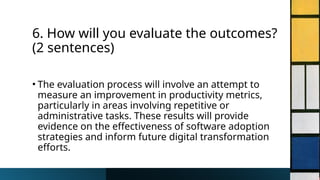Writing an Abstract: A Question-based Approach
- 2. What is an Abstract? • A research abstract is a brief summary of a research project that gives the reader a quick overview of the key points, helping them decide whether the full document is relevant to their interests.
- 3. Questions 1. What is the area of study? (1 sentence) 2. What is the problem being tackled? (1 sentence) 3. What does the literature say? (1 sentence) 4. How will you tackle the problem? (2 sentences) 5. How will you implement the solution? (2 sentences) 6. How will you evaluate the outcomes? (2 sentences)
- 4. Questions •So let’s look at sample answers for each question:
- 5. 1. What is the area of study? (1 sentence) • This research focuses on workplace productivity and the impact of digital tools within organizational settings.
- 6. 2. What is the problem being tackled? (1 sentence) • Organizations often invest in new software with the aim of improving efficiency, but the actual impact on productivity is not always clear.
- 7. 3. What does the literature say? (1 sentence) • Previous studies suggest that while software can enhance task automation and communication, measurable productivity gains depend on user adoption and process integration.
- 8. 4. How will you tackle the problem? (2 sentences) • A case study will be conducted focusing of a single department within a medium-sized organization, collecting productivity data from before and after the introduction of the new software. Key performance indicators (KPIs) such as task completion rate, error reduction, and employee feedback will be used to assess changes.
- 9. 5. How will you implement the solution? (2 sentences) • Quantitative data will be gathered from internal performance reports, while qualitative data will be collected through staff interviews and surveys. A comparative analysis will be conducted to identify statistically significant differences in performance pre- and post-software implementation.
- 10. 6. How will you evaluate the outcomes? (2 sentences) • The evaluation process will involve an attempt to measure an improvement in productivity metrics, particularly in areas involving repetitive or administrative tasks. These results will provide evidence on the effectiveness of software adoption strategies and inform future digital transformation efforts.
- 11. Questions •So now all we have to do is join them all together:
- 12. This research focuses on workplace productivity and the impact of digital tools within organizational settings. Organizations often invest in new software with the aim of improving efficiency, but the actual impact on productivity is not always clear. Previous studies suggest that while software can enhance task automation and communication, measurable productivity gains depend on user adoption and process integration. A case study will be conducted focusing of a single department within a medium-sized organization, collecting productivity data from before and after the introduction of the new software. Key performance indicators (KPIs) such as task completion rate, error reduction, and employee feedback will be used to assess changes. Quantitative data will be gathered from internal performance reports, while qualitative data will be collected through staff interviews and surveys. A comparative analysis will be conducted to identify statistically significant differences in performance pre- and post-software implementation. The evaluation process will involve an attempt to measure an improvement in productivity metrics, particularly in areas involving repetitive or administrative tasks. These results will provide evidence on the effectiveness of software adoption strategies and inform future digital transformation efforts.












